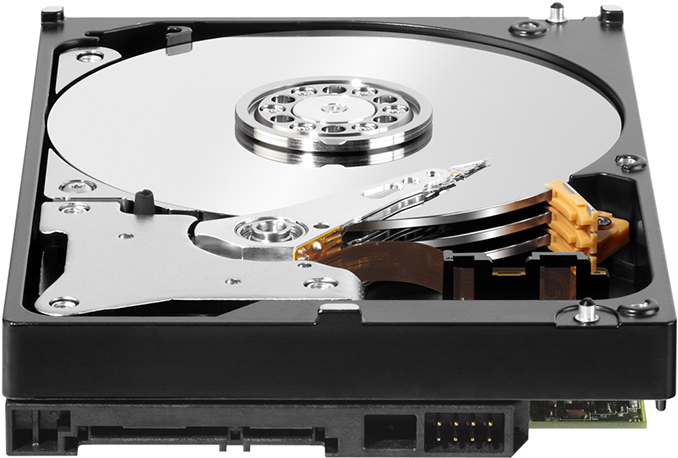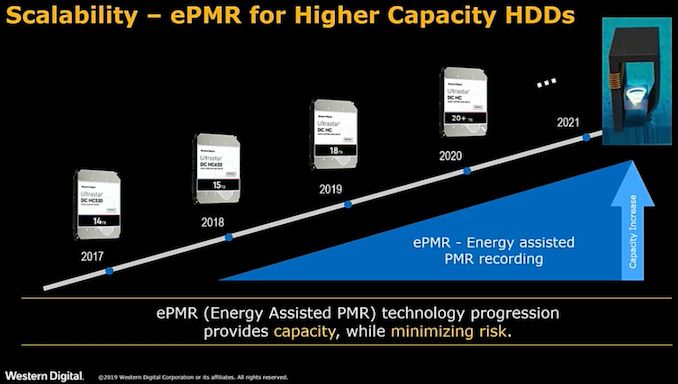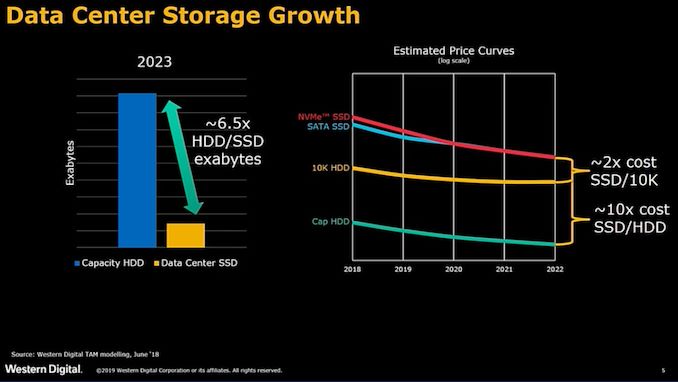Western Digital: Over Half of Data Center HDDs Will Use SMR by 2023
by Anton Shilov on March 19, 2019 10:30 AM EST- Posted in
- HDDs
- Storage
- Western Digital
- SMR
- MAMR

Western Digital said at OCP Global Summit last week that over half of hard drives for data centers will use shingled magnetic recording (SMR) technology in 2023. At present Western Digital is the only supplier of SMR HDDs managed by hosts, but the technology is gaining support by hardware, software, and applications.
SMR technology to boost capacity of hard drives fairly easily but at the cost of some performance trade-offs due to the read-modify-write cycle introduced by shingled tracks. Since operators of datacenters are interested in maximizing their storage capacities, they are inclined to invest in software that can mitigate peculiarities of SMR. As a result, several years after Western Digital introduced its first host-managed SMR HDDs, more and more companies are adopting them. Right now, the vast majority of datacenter hard drives are based on perpendicular magnetic recording technology, but WD states that in four years SMR HDDs will leave PMR drives behind.
Obviously, usage of SMR will not be the only method to increase capacities of hard drives. Energy-assisted PMR technologies (e.g., MAMR, HAMR, etc.) will also be used by Western Digital. In the coming quarters the company intends to release MAMR-based HDDs featuring a 16 TB (ePMR) and 18 TB (eSMR) capacity. The company also plans to introduce 20 TB HDDs in 2020.
High-capacity hard drives are not going to be replaced by high-capacity SSDs any time soon, according to Western Digital. HDDs will continue to cost significantly less than SSDs on per-TB basis. Therefore, they will be used to store 6.5 times more data than datacenter SSDs in 2023.
Related Reading:













33 Comments
View All Comments
mode_13h - Thursday, March 21, 2019 - link
Have you heard the term "big data"? You're not considering things like transaction databases or all the vast data collected about users and their activity.IoT can also generate vast amounts of data.
yankeeDDL - Tuesday, March 19, 2019 - link
In general, I'd say that I agree. Still, today many laptops are shipped with 256GB SSD/NVMe, which is, frankly, ludicrous, when any decent camera (and I'm not even talking DSLR here), can generate 40-50GB of photos and videos during one holiday.No, you don't *have* to keep all your photos on your laptop, but add a few games, and you can't even dump one vacation worth of photos on your laptop.
SSD needs to start at 1TB at a decent price, then we can talk about HDD being used only for Youtube stuff. We're not there yet. Not, by a large margin.
brakdoo - Tuesday, March 19, 2019 - link
Yeah we are getting there. 512 GB is much ore common than 2 years ago and the prices for 1 TB are just ~20% higher than 256 GB about 18 months ago.mode_13h - Tuesday, March 19, 2019 - link
So, I guess you think those trends will just continue, indefinitely? Did you ever actually think about why flash has gotten cheaper?Must be nice to be so naïve.
frenchy_2001 - Thursday, March 21, 2019 - link
Flash has gotten cheaper through vertical integration.There are plans going over 200 layers (we're at 96 layers now), so density should keep going up.
QLC is also coming.
So, I would say that in the medium term (5~10 years), we should still see price pressure on NAND storage.
mode_13h - Saturday, March 23, 2019 - link
96 layers, up from 1 layer, originally. So, while a further doubling will be nice, it's just a factor of 2.QLC-based products have already been on the market for more than half a year. Indeed, they are cheaper (and slower) than TLC.
Basically, NAND flash is now going to follow the same cost curve as DRAM. The bag of tricks for continuing to beat that curve is virtually empty. And what's happened 'till now has improved pricing, but at the cost of performance, endurance, and persistence.
DanNeely - Tuesday, March 19, 2019 - link
1tb m.2 sata can be found for $120 on amazon, $150 for NVME. That's cheap enough they should be an option for mid-range general purpose laptops, and that it should completely replace the 256ssd + 1tb hdd combo common in many slightly above entry level gaming laptops, although the bigger total numbers to impress the ignorant segment might repeat the deal with 2tb hdds I suppose. (Although that at least is enough of a capacity bump that it wouldn't be totally unreasonable IMO.)flyingpants265 - Tuesday, March 19, 2019 - link
It's $119 for the Intel 660p NVMe.yankeeDDL - Wednesday, March 20, 2019 - link
The consumer's price is "irrelevant". HP just announced new Envy laptops (https://www.anandtech.com/show/14103/hp-reveals-en... I, for one, am looking forward to get one with Ryzen 7 3700U. But 256GB for a 700/800usd laptop seems ridiculous. The problem is that I can buy another SSD (a decent one, no 660p, please!) for 200-250usd, BUT, this is still a significant adder to the laptop total cost, AND I will be stuck with a useless 256GB.I mean, high-end mobile phones these days have more RAM AND storage space than a mid-range laptop ...
zepi - Thursday, March 21, 2019 - link
High-end mobile phones also cost more.